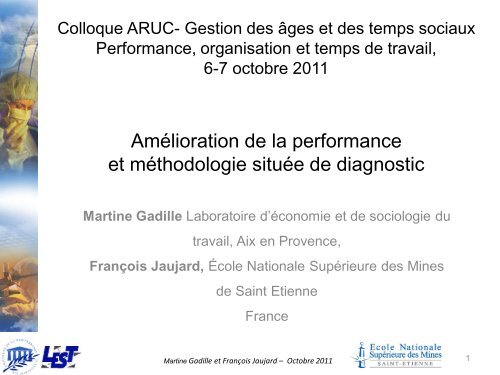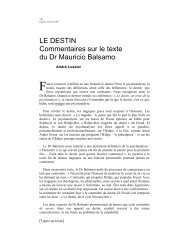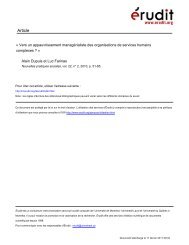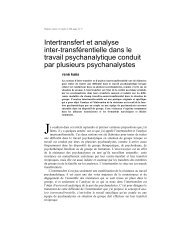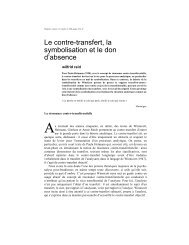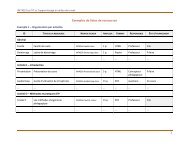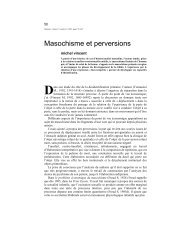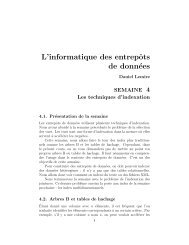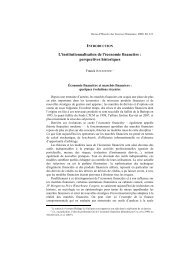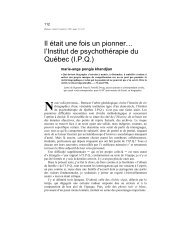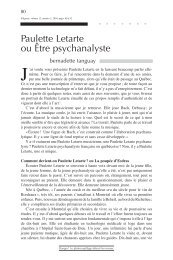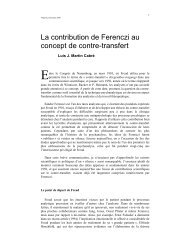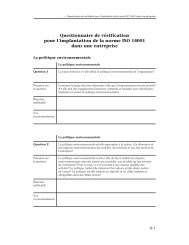Amélioration de la performance et méthodologie située de diagnostic
Amélioration de la performance et méthodologie située de diagnostic
Amélioration de la performance et méthodologie située de diagnostic
- No tags were found...
You also want an ePaper? Increase the reach of your titles
YUMPU automatically turns print PDFs into web optimized ePapers that Google loves.
Colloque ARUC- Gestion <strong>de</strong>s âges <strong>et</strong> <strong>de</strong>s temps sociauxPerformance, organisation <strong>et</strong> temps <strong>de</strong> travail,6-7 octobre 2011Amélioration <strong>de</strong> <strong>la</strong> <strong>performance</strong><strong>et</strong> méthodologie située <strong>de</strong> <strong>diagnostic</strong>Martine Gadille Laboratoire d’économie <strong>et</strong> <strong>de</strong> sociologie dutravail, Aix en Provence,François Jaujard, École Nationale Supérieure <strong>de</strong>s Mines<strong>de</strong> Saint EtienneFranceMartine Gadille <strong>et</strong> François Jaujard – Octobre 20111
Première partieLa gestion <strong>et</strong> l’évaluation <strong>de</strong> <strong>la</strong> <strong>performance</strong> au travail : unmodèle pluralisteMartine Gadille <strong>et</strong> François Jaujard – Octobre 20112
Crise <strong>de</strong> <strong>la</strong> <strong>performance</strong> au travail ?• Enjeux importants : reconnaissance, estime <strong>de</strong> soi,i<strong>de</strong>ntités (Dejours, 2003).• Un processus impossible ? (Reyre, 2007).• Vives insatisfactions dans les organisations (BenhamouS., Diaye M.A., Centre d’analyse stratégique, 2011).• Définition / c<strong>la</strong>rté <strong>de</strong>s objectifs• Traçabilité / visibilité du travail accompli• Insuffisance indicateurs / processus• SubjectivitéMartine Gadille <strong>et</strong> François Jaujard – Octobre 20113
Performance <strong>et</strong> méthodologie <strong>de</strong> <strong>diagnostic</strong> situés• Approche consultants vers directions d’entreprises (Drucker,1977) :– normes <strong>de</strong> <strong>performance</strong>,– fixation d’objectifs, organisation du travail,– motivation, communication, formation <strong>de</strong>s employés• Travaux <strong>de</strong> recherche : insuffisante conceptualisation <strong>de</strong> <strong>la</strong><strong>performance</strong> au travail, données empiriques hétérogènes(Motowidlo, 2003).Pas d’unité conceptuelle d’analyse <strong>de</strong> <strong>la</strong> <strong>performance</strong> face à <strong>la</strong>diversité <strong>de</strong>s pratiques : concept <strong>de</strong> « <strong>performance</strong> située »,s’appuyant sur une méthodologie <strong>de</strong> « <strong>diagnostic</strong> situé ».Martine Gadille <strong>et</strong> François Jaujard – Octobre 20114
Trois objectifs <strong>de</strong> <strong>performance</strong> à concilier• Attentes <strong>de</strong>s marchés : <strong>de</strong>s produits (Drucker, 1999) <strong>et</strong>financiers- « c’est le consommateur, ses valeurs <strong>et</strong> ses décisions » quifon<strong>de</strong>nt le management <strong>et</strong> <strong>la</strong> <strong>performance</strong> <strong>de</strong> l’entreprise.- actionnariat à l’autre bout• Attentes <strong>de</strong>s gestionnaires (Hémard, 2009)Dispositif <strong>de</strong> gestion RH visant <strong>la</strong> rationalisation : allocation<strong>de</strong>s augmentations, promotions, actions <strong>de</strong> formation,mobilités.• Attentes <strong>de</strong>s sa<strong>la</strong>riés (Tessier <strong>et</strong> al., 2008)gestion <strong>de</strong> carrières, équité, reconnaissance <strong>de</strong>sapprentissages, d’é<strong>la</strong>rgissement <strong>de</strong>s capacités d’action, <strong>de</strong>si<strong>de</strong>ntités individuelles <strong>et</strong> <strong>de</strong> groupe, socialisation.Martine Gadille <strong>et</strong> François Jaujard – Octobre 20115
Trois Modèles (d’après Tessier <strong>et</strong> al., 2008)Modèle <strong>de</strong> marchéModèle <strong>de</strong>s re<strong>la</strong>tionshumaines, du c<strong>la</strong>n, <strong>de</strong><strong>la</strong> socialisationModèle <strong>de</strong> <strong>la</strong> compétence<strong>et</strong> <strong>de</strong> <strong>la</strong> responsabilisationContexte Service, chaîne , atelier Groupe, équipe Sous-groupes, îlots,équipes proj<strong>et</strong>sFinalitéOptimisation : travail,allocation ressourcesAccompagnentintégration <strong>et</strong> i<strong>de</strong>ntitéEngagement <strong>et</strong> autonomiedans <strong>et</strong> du groupeCritèresRapport àl’individuEvaluation : mesure,contrôle, c<strong>la</strong>ssement<strong>de</strong>s résultatsIndividu = ressourcemaîtrise du posteAppréciation : dialogue,proximitéintérêts individuelsconvergentsEvaluation <strong>de</strong>s écarts <strong>de</strong>compétence individuelles <strong>et</strong>collectivesIndividu = potentielRapport aucollectifSolidarité mécanique<strong>performance</strong> par <strong>la</strong>socialisationIntériorisation <strong>de</strong> normesexploitation <strong>et</strong> exploration,QuestionnementNormes <strong>et</strong> sur<strong>performance</strong>?Diversité intégrée estellepossible ?Quid <strong>de</strong>s profilsd’exploration hors normes ?Martine Gadille <strong>et</strong> François Jaujard – Octobre 20116
Contemporanéité <strong>et</strong> questionnements du modèle : vers unprocessus d’hybridation ?• Hypothèse à vali<strong>de</strong>r d’un processus contemporaind’hybridation <strong>de</strong>s trois modèles.• Trois questionnements :1. Mise en tension <strong>de</strong>s membres <strong>de</strong>s organisations entre :• <strong>la</strong> prescription <strong>et</strong> standardisation <strong>de</strong>s normes <strong>de</strong><strong>performance</strong>,• l’individuation <strong>de</strong> gestion (individus/groupes)2. Quelle nature <strong>de</strong>s processus d’apprentissageorganisationnel dans c<strong>et</strong>te tension ?3. La gestion <strong>de</strong> <strong>la</strong> <strong>performance</strong> entre contexteéconomique externe <strong>et</strong> mon<strong>de</strong>s sociaux internes.Martine Gadille <strong>et</strong> François Jaujard – Octobre 20117
Sélection <strong>de</strong>s cas <strong>et</strong> justification• Pratiques <strong>de</strong> <strong>la</strong> gestion <strong>de</strong> <strong>performance</strong> situées– Historique : historicité <strong>de</strong>s outils, métho<strong>de</strong>s <strong>de</strong> gestions <strong>et</strong> <strong>de</strong> <strong>la</strong>fonction RH– Spatial : entreprises globales / entreprises locales– Cycle <strong>de</strong> vie <strong>de</strong> l’entreprise :• Firme globale avec ancrage compétitif territorial : route <strong>de</strong>shautes technologie• Robotix : start up rach<strong>et</strong>ée, restructurée mise en bourse• Comprimair : PME innovante détenue par son créateur dansun intersticeMartine Gadille <strong>et</strong> François Jaujard – Octobre 2011
Cas 1 : Grand groupe européen <strong>de</strong> semi-conducteur :l’évaluation hybri<strong>de</strong> <strong>de</strong>s opérateurs <strong>de</strong> fabrication• Contexte : TQM, ilots <strong>de</strong> fabrication, team managers <strong>et</strong>responsabilisation du personnel.Ambigüité : liens avec l’atelier <strong>et</strong> l’équipe.• Finalité <strong>de</strong> l’évaluation : Excellence (formation, travail en équipe,expression <strong>de</strong> <strong>la</strong> créativité). Focus simultané : résultats,développement individuel, responsabilisation, compétences.• Critères : Référentiel <strong>de</strong> compétences <strong>et</strong> « comp<strong>et</strong>enscope »;Evaluations collectives <strong>de</strong>s ilots <strong>et</strong> individuellement<strong>de</strong> ses membres (résultats <strong>et</strong> « façons d’agir »).• Rapport à l’individu : rôles <strong>et</strong> responsabilisation dans l’ilot,augmentations individuelles, développement personnel.• Rapport au collectif : régu<strong>la</strong>tions entre membres <strong>et</strong> résultats,reconnaissance par Martine les Gadille pairs <strong>et</strong> François > Jaujard reconnaissance – Octobre 2011 hiérarchique 10
Cas 2 : Entreprise multi-secteur,restructurée dans <strong>la</strong> robotique <strong>et</strong> automatismes (150personnes)• Contexte : appartenance à une division 2008 (pétrole, industrielle,nucléaire, défense), direction <strong>de</strong> service <strong>et</strong> appartenance à ungroupe métier géré en tant que tel par RH (<strong>de</strong> 80 à 50 métiers)• Finalité <strong>de</strong> l’évaluation : optimisation résultats individuels,mesure du niveau <strong>de</strong> compétences attendues, harmoniser lesfiches métiers <strong>et</strong> équivalents fiches <strong>de</strong> poste (nuages points),transmission <strong>de</strong> savoirs par tuteurs• Critères <strong>de</strong> notation : compétences détenues 4 niveaux <strong>et</strong>objectifs atteints,• Rapport à l’individu : non experts évaluable <strong>et</strong> experts nonévaluable, sorti du contexte organisationnel• Rapport au collectif : régu<strong>la</strong>tion collective <strong>de</strong> <strong>la</strong> notationbinômes/trinômes Martine <strong>et</strong> Gadille comité <strong>et</strong> François dir, Jaujard non – Octobre valorisation 2011 <strong>de</strong>s groupes 11
Cas 3 : PME aux savoirs techniques <strong>de</strong> développementcompressoriste (30 sa<strong>la</strong>riés)• Contexte : l’atelier <strong>de</strong> <strong>la</strong> PME comme unité centraled’appartenance, émergence d’un bureau d’étu<strong>de</strong> <strong>et</strong> rationalisationd’un service commercial• Finalité <strong>de</strong> l’évaluation : appréciation <strong>de</strong> <strong>la</strong> maîtrise du poste, bienvivre dans le poste, connaissance <strong>de</strong>s aspirations <strong>et</strong> gestioncarrière, fixer mesures adaptatives, cohésion dans les services• Critères : résultats par rapport aux objectifs, adaptation globaleau poste, capacité <strong>de</strong> management cohésif, délégation, pilotage<strong>de</strong>s apprentissages, amélioration <strong>de</strong>s connaissances• Rapport à l’individu : objectifs par forcément quantifiables, équité(prime si 60% objectifs atteints),• Rapport au collectif : collectif ménagé, auto-organisation,communauté, re<strong>la</strong>tivisation Martine Gadille <strong>et</strong> François évaluation Jaujard – Octobre individuelle/collectif 201112
Troisième partieDiscussion <strong>de</strong>s modèles <strong>et</strong> <strong>de</strong>s donnéesMartine Gadille <strong>et</strong> François Jaujard – Octobre 201113
Synthèse <strong>de</strong>s modalités d’hybridation i<strong>de</strong>ntifiées à partir <strong>de</strong>s casContexteFinalitéCritèresRapport àl’individuRapport aucollectifModèle <strong>de</strong> marchémaîtrise du métier (<strong>de</strong>l’atelier)processus <strong>de</strong>reportingatteinte <strong>de</strong>sobjectifs court termeatteinte <strong>de</strong>s objectifsindividuelsatteinte <strong>de</strong>s objectifscollectifsModèle <strong>de</strong>sre<strong>la</strong>tions humaines,du c<strong>la</strong>n, <strong>de</strong> <strong>la</strong>socialisationéchanges en tempsréels (temporalité)apprentissage <strong>et</strong>expressionréflexivitéintérêts individuelsconvergentstravail d’équipeperformantModèle <strong>de</strong> <strong>la</strong>compétence <strong>et</strong> <strong>de</strong> <strong>la</strong>responsabilisationsituation <strong>de</strong> travailorganisationquotidienne du travailmobilisation <strong>de</strong>scompétences requisesdéveloppement dupotentiel individue<strong>la</strong>utonomie du groupe,gestion <strong>de</strong> l’incertitu<strong>de</strong>Apportsspécifiques<strong>de</strong> chaquemodèleApproche quantitativese vou<strong>la</strong>nt objective :gestion <strong>de</strong>s résultats /objectifs individuels <strong>et</strong>collectifsRe<strong>la</strong>tions /apprentissage /réflexivité / transfertconnaissancesd’expertMartine Gadille <strong>et</strong> François Jaujard – Octobre 2011Travail quotidien / miseen œuvre <strong>et</strong>développement <strong>de</strong>scompétences/ faire faceaux incertitu<strong>de</strong>s dans14un cadre prescrit
Les enjeux économique <strong>et</strong> sociaux <strong>de</strong> l’hybridation1. Mise en tension <strong>de</strong>s membres <strong>de</strong>s organisations :prescription <strong>et</strong> standardisation <strong>de</strong>s normes <strong>de</strong> <strong>performance</strong> /individualisation <strong>de</strong> gestion.–Contexte : autonomie <strong>de</strong> l’ilot ?–Finalité <strong>de</strong>s ilots : entité intégrée ou compétition d’ilots ?–Critères : résultats immédiats / développement individuel <strong>et</strong> collectif–Rapport à l’individu <strong>et</strong> au collectif : prescription <strong>et</strong> développementindividuel, <strong>la</strong> crise <strong>de</strong>s experts2. Processus d’apprentissage organisationnel nés <strong>et</strong> bornés parc<strong>et</strong>te tension–Organisé sur le terrain par nécessité, explicite <strong>et</strong> tacite, pression dugroupe sur l’individu–Non reconnaissance <strong>de</strong> capacités cognitives méta-organisationnelles3. Inférence <strong>de</strong>s systèmes <strong>de</strong> gestion <strong>de</strong> <strong>la</strong> <strong>performance</strong> du contexteéconomique externe ou <strong>de</strong>s mon<strong>de</strong>s sociaux internes.Martine Gadille <strong>et</strong> François Jaujard – Octobre 201115
Trois constats :Conclusion•Validation <strong>de</strong> l’hypothèse d’hybridation contemporaine•L’hybridation entre sédimentation <strong>et</strong> nécessité stratégique•Risques psychosociaux : transitions professionnelles <strong>et</strong>constructions i<strong>de</strong>ntitairesQuelle durabilité <strong>de</strong> <strong>la</strong> <strong>performance</strong> au travail ?- nécessité d’une cohérence entre les exigences <strong>de</strong>l’organisation <strong>et</strong> <strong>de</strong> celles <strong>de</strong> ses membres pour une<strong>performance</strong> organisationnelle- négociation <strong>et</strong> contractualisation comme conditionssocio-cognitives <strong>et</strong> économiques <strong>de</strong> l’apprentissageorganisationnel.Martine Gadille <strong>et</strong> François Jaujard – Octobre 201116


